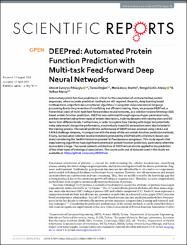| dc.contributor.author | Rifaioğlu, Ahmet Süreyya | |
| dc.contributor.author | Doğan, Tunca | |
| dc.contributor.author | Martin, Maria Jesus | |
| dc.contributor.author | Çetin-Atalay, Rengül | |
| dc.contributor.author | Atalay, Volkan | |
| dc.date.accessioned | 2019-07-04T12:03:04Z | |
| dc.date.available | 2019-07-04T12:03:04Z | |
| dc.date.issued | 2019 | en_US |
| dc.identifier.citation | Sureyya Rifaioglu, A., Doğan, T., Jesus Martin, M., Cetin-Atalay, R., Atalay, V. (2019). DEEPred: Automated Protein Function Prediction with Multi-task Feed-forward Deep Neural Networks. Scientific Reports. 9(1), 1-16. | en_US |
| dc.identifier.uri | http://dx.doi.org/10.1038/s41598-019-43708-3 | |
| dc.identifier.uri | https://hdl.handle.net/20.500.12508/397 | |
| dc.description | Science Citation Index Expanded | en_US |
| dc.description.abstract | Automated protein function prediction is critical for the annotation of uncharacterized protein sequences, where accurate prediction methods are still required. Recently, deep learning based methods have outperformed conventional algorithms in computer vision and natural language processing due to the prevention of overfitting and efficient training. Here, we propose DEEPred, a hierarchical stack of multi-task feed-forward deep neural networks, as a solution to Gene Ontology (GO) based protein function prediction. DEEPred was optimized through rigorous hyper-parameter tests, and benchmarked using three types of protein descriptors, training datasets with varying sizes and GO terms form different levels. Furthermore, in order to explore how training with larger but potentially noisy data would change the performance, electronically made GO annotations were also included in the training process. The overall predictive performance of DEEPred was assessed using CAFA2 and CAFA3 challenge datasets, in comparison with the state-of-the-art protein function prediction methods. Finally, we evaluated selected novel annotations produced by DEEPred with a literature-based case study considering the ‘biofilm formation process’ in Pseudomonas aeruginosa. This study reports that deep learning algorithms have significant potential in protein function prediction; particularly when the source data is large. The neural network architecture of DEEPred can also be applied to the prediction of the other types of ontological associations. The source code and all datasets used in this study are available at: https://github.com/cansyl/DEEPred. | en_US |
| dc.language.iso | eng | en_US |
| dc.publisher | Nature Publishing Group | en_US |
| dc.relation.isversionof | 10.1038/s41598-019-43708-3 | en_US |
| dc.rights | info:eu-repo/semantics/openAccess | en_US |
| dc.subject.classification | Proteins | Genes | Protein functions | en_US |
| dc.subject.classification | Multidisciplinary Sciences | en_US |
| dc.subject.other | sequence | en_US |
| dc.subject.other | annotation | en_US |
| dc.subject.other | alignment | en_US |
| dc.title | DEEPred: Automated Protein Function Prediction with Multi-task Feed-forward Deep Neural Networks | en_US |
| dc.type | article | en_US |
| dc.relation.journal | Scientific Reports | en_US |
| dc.contributor.department | Mühendislik ve Doğa Bilimleri Fakültesi -- Elektrik-Elektronik Mühendisliği Bölümü | en_US |
| dc.contributor.authorID | 0000-0001-6717-4767 | en_US |
| dc.contributor.authorID | 0000-0002-1298-9763 | en_US |
| dc.contributor.authorID | 0000-0001-5454-2815 | en_US |
| dc.contributor.authorID | 0000-0001-7850-0601 | en_US |
| dc.identifier.volume | 9 | en_US |
| dc.identifier.issue | 1 | en_US |
| dc.identifier.startpage | 1 | en_US |
| dc.identifier.endpage | 16 | en_US |
| dc.relation.publicationcategory | Makale - Uluslararası Hakemli Dergi - Kurum Öğretim Elemanı | en_US |
| dc.contributor.isteauthor | Rifaioğlu, Ahmet Süreyya | en_US |
| dc.relation.index | Web of Science - Scopus - PubMed | en_US |
















